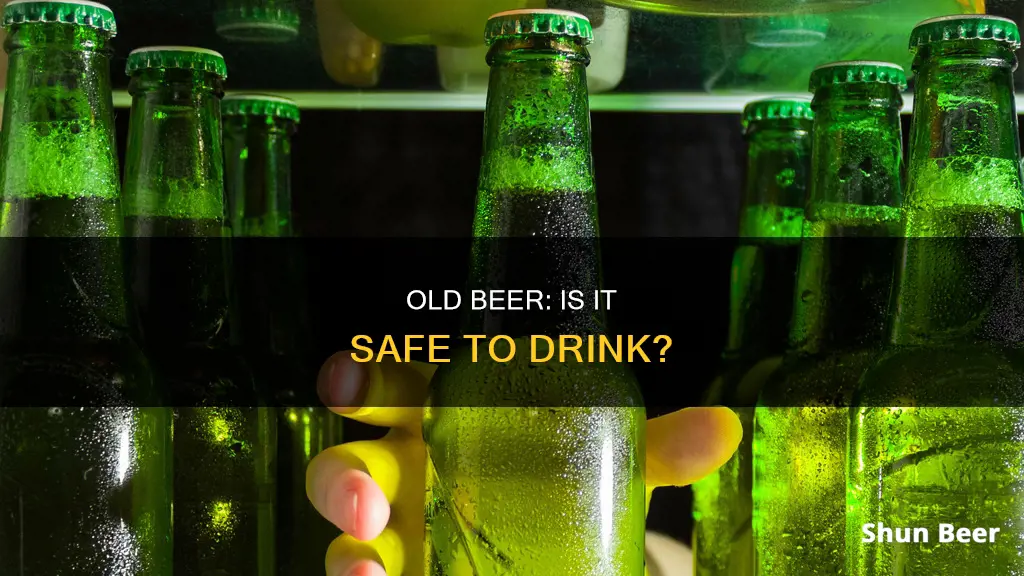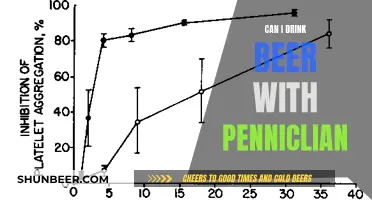
Beer is just like any other food – it has a shelf life and will eventually go off. However, drinking old beer is harmless and non-toxic. The main issue with drinking beer past its best is that it won't taste very nice. It's likely to smell odd and taste stale or flat. Beer is best consumed as close to the packaging date as possible, as this is when it is at its freshest.
| Characteristics | Values |
|---|---|
| Shelf life | Varies depending on the type of beer and how it is stored. Sealed beer can last between 6 to 12 months without refrigeration. Refrigerated sealed beer can last beyond its expiration date up to 12 months. Beer stored in clear bottles degrades faster than beer stored in dark bottles or cans. |
| Expiration date | Beer does have an expiration date, but it is not harmful to drink expired beer. It is recommended to drink beer as close to the packaging date as possible, as it will be freshest. |
| Taste | Beer tends to lose flavor and other key characteristics over time. |
| Health concerns | Drinking expired beer is not toxic and will not make you sick. However, unpasteurized beer should not be consumed stale as it can make you sick. |
| Storage | Beer should be stored in a dark place, out of direct sunlight, and at a temperature between 50 to 55 degrees Fahrenheit. |
What You'll Learn

Is old beer toxic?
Beer has a shelf life and will expire, whether opened or closed. However, drinking old or expired beer is not toxic and is unlikely to make you sick. The only issue with drinking old beer is that it will not taste as good as fresh beer.
Like wine, beer ages even after bottling. However, unlike wine, beer's taste gets worse over time rather than improving. The decrease in taste is due to three factors: hops, light, and oxygen. Hops oxidize over time, causing the aroma and flavour compounds to dissipate. Beer also continues to react with oxygen, which can result in sweet, sherry-like flavours. The speed of these reactions depends on the alcohol content of the beer and how it is stored.
To prolong the shelf life of beer, it should be stored in a dark place, out of direct sunlight, and at the right temperature. Standard beers, such as IPAs or stouts, are usually stored at 50 to 54°F (10 to 12°C), while lighter beers such as pilsners and lagers should be stored a bit cooler. Canned beer is also likely to last longer than bottled beer because it is airtight.
While drinking old beer is not toxic, it is important to note that beer does have an expiration date. If proper preservation methods are followed, beer can last for some time after the printed expiration date. Beer that is left unopened and stored in a cold environment can last up to two years. After this point, the beer will become stale and have an undesirable smell, but it is still technically consumable.
Drinking Beer Without Gaining Weight: Is It Possible?
You may want to see also

How long does beer last?
Beer does have an expiration date and it does go bad, but it won't make you sick. The fermentation process used in brewing, as well as its low pH level and alcohol content, make beer an unfriendly environment for microorganisms. So, even if a beer sits on the shelf for years, as long as it's sealed, it's unlikely to make you sick.
The average shelf life of beer is about 6 to 8 months without refrigeration. If stored and refrigerated properly, sealed beer can last beyond its expiration date up to 12 months. Opened beer has a shelf life of about a day, regardless of the expiration date listed.
The shelf life of beer varies depending on the type and storage conditions. Most beers are best consumed within 6 to 9 months if stored at room temperature. Refrigeration can extend this period to up to 2 years. Unpasteurized or craft beers may have a shorter shelf life.
Higher ABV beers (8% and above) like Stouts and Barleywines taste better with age so leaving them on the shelf for a few years is ideal, provided they are stored properly.
There are three main factors that cause beer to lose its quality: light exposure, oxygen exposure, and bacteria exposure. Exposure to light, especially UV light, can cause beer to develop a skunky odour and taste. This is more common in beers packaged in clear or green bottles. Brown bottles offer better protection, and cans completely shield beer from light.
Oxidation is a chemical reaction that takes place when oxygen molecules interact with the molecules of beer and its ingredients. It can cause a papery or cardboard-like taste. Heat speeds up oxidation, so storing beer in a refrigerator is recommended.
Bacterial infections in beer are rare because the alcohol content in beer acts as a natural preservative. However, if bacteria finds its way into the beer, it will start to multiply. Unpasteurized craft beer can be protected by refrigeration as colder temperatures slow down the life cycle of microbes like yeast.
To store beer right, it should be kept in a cool, dark place, preferably the refrigerator. If storing at room temperature, choose a cool, dark room that undergoes minimal temperature fluctuations. Basements are a good choice. Keep the beer standing upright to minimize the surface area exposed to oxidation.
Beer and Back Pain: Is There a Link?
You may want to see also

How to store old beer?
Storing old beer correctly is crucial to maintaining its quality and preventing common issues such as spoilage and a decline in taste. Here are some detailed instructions on how to store old beer:
Choose the Right Container
The container you choose to store your beer in is important. Canned beer is ideal as it is airtight and blocks out light, preventing "skunking" or "lightstrike". If you're using bottles, brown bottles are preferable as they minimise the effects of light strike by blocking out light under 500nm. Green bottles can only block light below 400nm (ultraviolet light), while clear bottles offer no protection.
Store Beer Upright
It is recommended to store beer upright rather than on its side. Storing beer upright limits the amount of beer exposed to oxygen, slowing the rate of oxidation and preventing off-flavours from developing. Storing beer upright also ensures that yeast compacts at the bottom of the bottle, minimising its influence on the flavour.
Control Temperature
Beer should be stored in a cool, dry place, ideally between 45 and 55 degrees Fahrenheit (7-12 degrees Celsius) for packaged beer, and 50-55 degrees Fahrenheit (10-16 degrees Celsius) for strong beers. Avoid freezing temperatures as this can alter the taste. Refrigeration is generally recommended, but not for beers meant to be cellared/aged, as this can slow the development of flavours.
Avoid Light and Heat
Keep beer away from direct sunlight and sources of heat. Exposure to sunlight can cause "skunking", resulting in an unpleasant taste and smell. Heat will accelerate the chemical breakdown of the beer, causing it to age faster and develop off-flavours.
Maintain Humidity
For corked bottles, ensure the storage environment has adequate humidity to prevent the cork from drying out and cracking. Optimal humidity for storing beer is between 50% and 70%.
Consume Opened Beer Promptly
Once a beer is opened, it should be consumed as soon as possible. Opened beer will quickly lose carbonation and become flat, affecting its taste and texture.
Other Considerations
- Avoid excessive movement of stored beer, as this can cause chemical changes that affect its flavour.
- If you are creating a beer cellar, maintain a cool temperature (around 10 degrees below the beer's fermentation temperature) and store beer in a dark place, away from direct sunlight.
- For home-brewed beer, use glass bottles or kegs and store them somewhere warm during the final stage of fermentation.
- If you plan to store multiple kegs, follow the first-in-first-out rule and keep them in a cool, dry space, away from other foods.
By following these guidelines, you can effectively store old beer and preserve its quality for a longer period.
Old Beer: Is It Safe to Drink After 5 Years?
You may want to see also

Is it safe to drink expired beer?
Like any other food or drink, beer has a shelf life. However, unlike other consumables, drinking expired beer is not harmful to your health. It is completely harmless and non-toxic. The only downside is that it might not taste very nice. It is likely to smell odd and taste stale or flat.
Beer will expire whether it is opened or not, but it will last longer if it is left unopened. Opened beer will go flat as it is exposed to oxygen, and this process is sped up if the beer is left in a hot environment. Beer stored in a cold, dark place will last longer.
Sealed beer is shelf-stable for 6-8 months without refrigeration. If it is stored in a refrigerator, sealed beer can last beyond its expiration date for up to 12 months. Beer stored in clear bottles will degrade in quality more quickly, whereas beer with a higher alcohol content (above 9%) can be kept for longer.
The taste of expired beer depends on several factors, including the type of beer, how it has been packaged and stored, and the ABV composition. If the beer has lost its carbonation, it will taste flat. It may also taste like rotting fruit, sherry, soggy cardboard, or wet paper.
There are three main factors that cause beer to expire: light exposure, oxygen exposure, and bacteria exposure. Exposure to ultraviolet (UV) rays can cause the hop-derived compounds in beer to break down and combine with a sulphuric compound, creating a skunky odour and taste. Oxidation is a chemical reaction that takes place when oxygen molecules interact with the molecules in the beer and other ingredients, causing a loss of flavour. Bacterial infections in beer are rare, but if they occur, the bacteria will eat away at the beer.
Beer and Clomid: Safe Mix or Health Risk?
You may want to see also

What does old beer taste like?
Old beer is typically characterised by a stale or flat taste and an odd smell. The beer will lose its desired smell and taste as the organic compounds within it go bad. This process is accelerated by exposure to oxygen, which occurs when a bottle or can of beer is left open, and by exposure to heat.
The flavour of old beer is influenced by three main factors: hops, light, and oxygen. Exposure to light, specifically ultraviolet (UV) rays, can cause the hop-derived compounds in beer to break down and combine with a sulphuric compound, resulting in an odour similar to that of a skunk. This process can occur with just a few seconds of light exposure and affects beers with higher hop content, such as IPAs, more than those with lower hop content, like American Lagers.
Oxidation, the chemical reaction that occurs when oxygen molecules interact with the molecules of beer and its flavour-imparting ingredients, can also impact the taste of old beer. In dark beers, oxidation can convert malt flavours to those of rotting fruit or sherry. In light-coloured beers, oxidation will remove hoppy, malty flavours, leaving the beer tasting like wet paper. However, in rare cases, oxidation can improve the flavour of certain beers, such as Lambics, when done deliberately under controlled temperatures during the barrelling process.
Bacterial infections in beer are rare due to the alcohol content acting as a natural preservative. However, if bacteria are present, they will consume the beer, causing it to spoil. Unpasteurised craft beers are particularly susceptible to bacterial growth and should be consumed fresh.
Drinking Beer While on Norvasc: What You Need to Know
You may want to see also
Frequently asked questions
Drinking old beer is harmless and non-toxic. However, it might not taste good and is likely to smell odd and taste stale or flat.
Beer has a shelf life of six months to a few years, depending on various factors. Sealed beer is shelf-stable for 6 to 8 months without refrigeration. If stored and refrigerated properly, sealed beer can last beyond its expiration date, up to 12 months or even two years.
One of the first ways to tell is by paying attention to the noise the beer makes when you open it. If there's no hissing sound, it means the beer has lost its carbonation and gone flat. You can also check the bottle for dust, which indicates it has been sitting on the shelf for a while.







